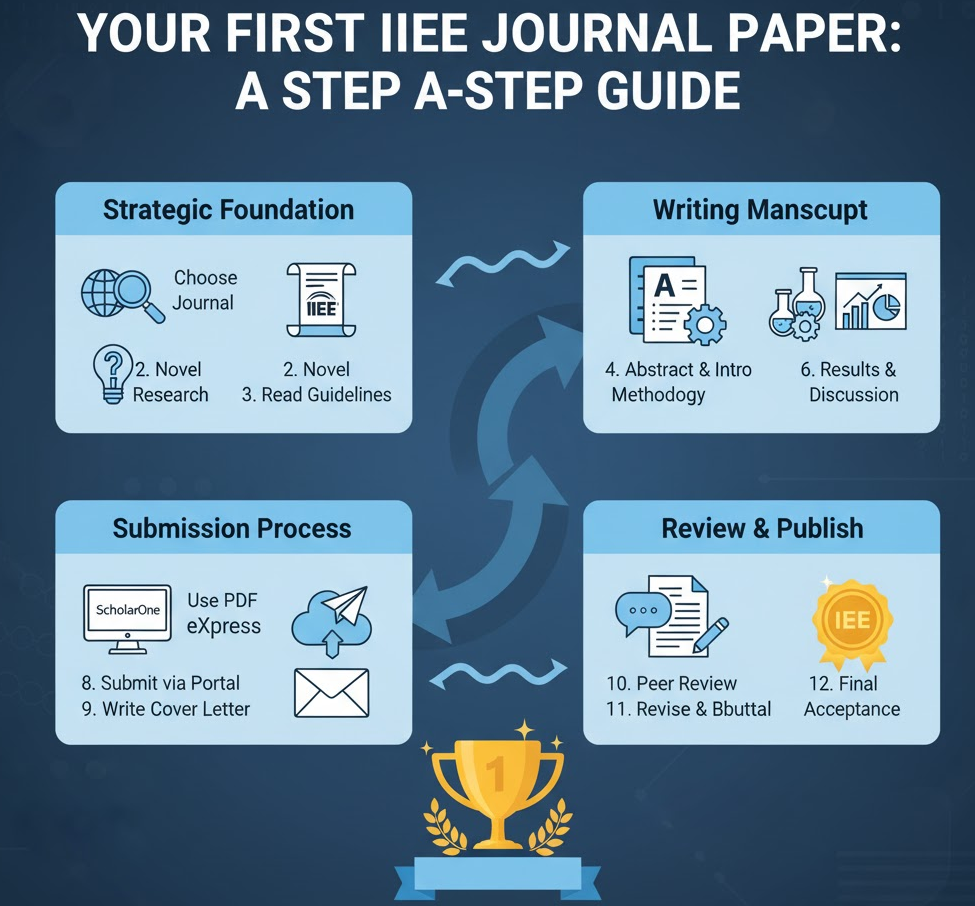

244 views||Release time: Oct 16, 2025
For engineers, computer scientists, and researchers in technical fields, publishing in a journal from the Institute of Electrical and Electronics Engineers (IEEE) is a globally recognized mark of quality and impact. Successfully navigating this process for the first time is a challenging but incredibly rewarding journey.
This guide provides a complete, step-by-step roadmap for first-time authors, covering everything from the foundational strategy to the detailed mechanics of the submission process, helping you turn your research into a published IEEE paper.

Step 1: Ensure Your Research is Ready and Novel An IEEE journal paper requires more than just solid work; it demands a novel contribution. Before you begin, you must be able to clearly answer: "What is the new, original contribution of this paper to the existing body of knowledge?" Your work should be a complete story with robust results, not just a preliminary finding.
Step 2: Choose the Right IEEE Journal (The Most Critical Step) Submitting to the wrong journal is the most common reason for desk rejection.
Use the IEEE Publication Recommender: This powerful tool allows you to paste your abstract or keywords and receive a list of relevant IEEE journals and conferences.
Meticulously Read the "Aims & Scope": On the journal's page in the IEEE Xplore digital library, find the "Aims & Scope" section. If your work doesn't perfectly align with it, your paper will be rejected.
Analyze Recent Articles: Read the titles and abstracts of papers published in the last few issues. Does your work fit in? Is the technical depth of your paper comparable?
Consult Your Supervisor: Your professor or mentor's experience is invaluable. They can provide the best guidance on which journal is the right fit for the prestige and nature of your work.
Step 3: Download and Study the Author Guidelines and Template Every IEEE journal has a specific template (available for both LaTeX and Word) and detailed author instructions. Download these immediately and read them carefully. Following these formatting rules precisely is non-negotiable.
Step 4: Craft a Powerful Abstract and Introduction
Abstract: This is your paper's 150-250 word advertisement. It must be a perfect, self-contained summary of your work, covering the problem, your method, the key results, and the conclusion.
Introduction: This is your chance to hook the reviewers. Clearly establish the context, summarize the state-of-the-art, identify the existing research gap, and then explicitly state your paper's contributions.
Step 5: Detail Your Methodology with Rigor This section must provide enough detail for another expert in your field to replicate your work. Be precise, clear, and thorough in describing your experimental setup, algorithms, or theoretical framework.
Step 6: Present Your Results and Write a Thoughtful Discussion Clearly separate your findings from your interpretation.
Results: Present your data objectively, using high-quality figures and tables.
Discussion: Interpret what your results mean. How do they answer your research question? How do they compare to previous work? What are the broader implications and limitations of your study?
Step 7: Create Professional-Grade Figures and Tables All visuals must be high-resolution, legible, and have clear, descriptive captions. They should be understandable on their own.
Step 8: Final Polish and Pre-Submission Checks
Proofread Endlessly: Eliminate all grammatical errors and typos. Ask a native English speaker or use a professional editing service if possible.
Use IEEE PDF eXpress: This is a mandatory step for most IEEE journals. It is an online tool that checks your PDF file for compliance with IEEE Xplore's standards. You upload your draft, and the tool either validates it or converts it into a compliant PDF for you to download.
Step 9: Submitting via the ScholarOne Manuscripts Portal Most IEEE journals use a portal called ScholarOne Manuscripts. The process is as follows:
Create an Account: Set up your author account on the journal's submission site.
Enter Manuscript Details: You will be asked to enter the title, abstract, and all co-author details.
Write a Cover Letter: This is a brief, professional letter to the Editor-in-Chief. Introduce your paper, state its key contribution, and explain why it is a good fit for the journal.
Suggest Reviewers (if applicable): Some journals allow you to suggest 3-5 potential reviewers who are experts in your field (and have no conflict of interest).
Upload Files: Upload your final, PDF eXpress-compliant manuscript, as well as any supplementary materials or source files as required.
Review and Submit: Carefully review all the information you've entered and then click "Submit."
Step 10: The Review Process Be patient. The peer-review process for an IEEE journal can take anywhere from three to twelve months. You can check the status of your paper ("Under Review," "Awaiting Decision," etc.) in the ScholarOne portal.
Step 11: Respond to Reviewer Comments If you receive a "Major Revisions" or "Minor Revisions" decision, this is great news! It means the journal is interested. You will need to carefully revise your manuscript and write a detailed, point-by-point rebuttal letter that respectfully addresses every comment from the reviewers.
Step 12: Acceptance and Final Steps Once your paper is accepted, you will need to submit the final "camera-ready" source files and complete the electronic IEEE Copyright Form.
Conclusion Publishing your first IEEE journal paper is a marathon that tests your research skills, writing ability, and persistence. By being strategic in your journal choice, meticulous in your preparation, and professional in your communication, you can successfully navigate this process and earn your place in the permanent record of high-impact engineering and technology research.